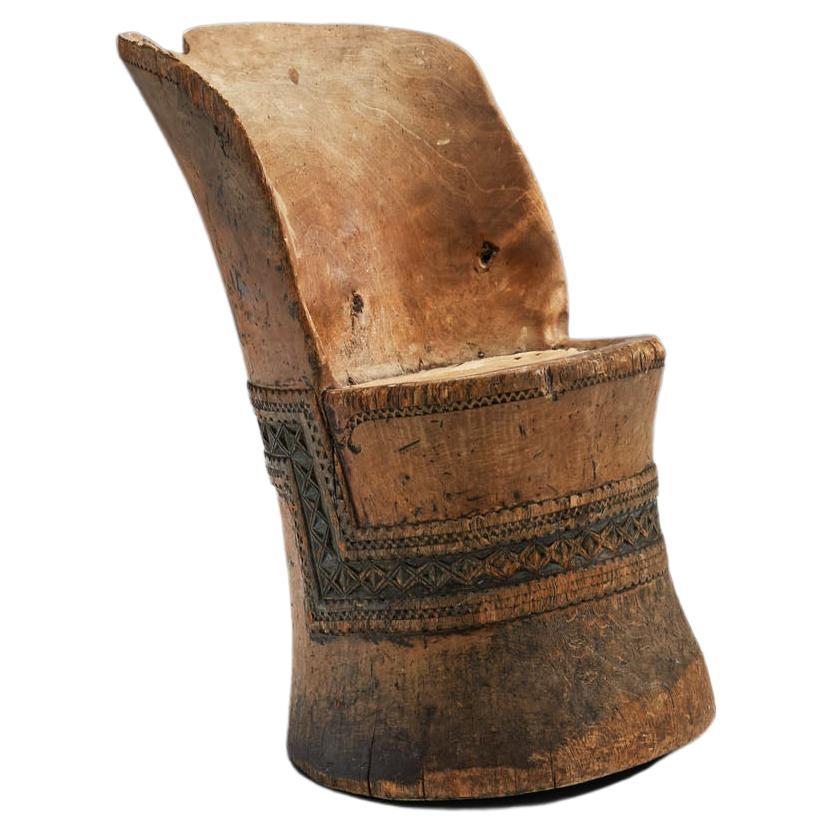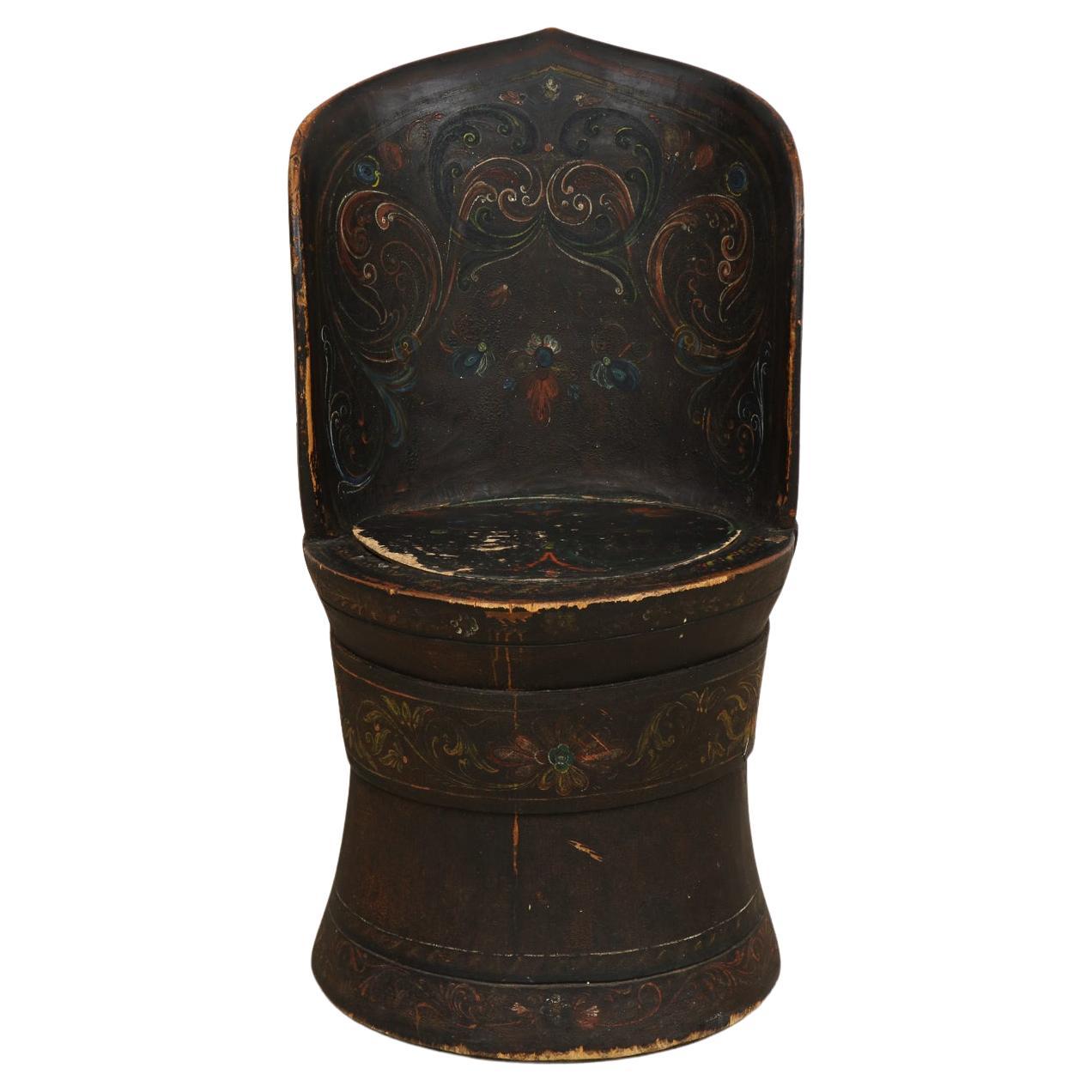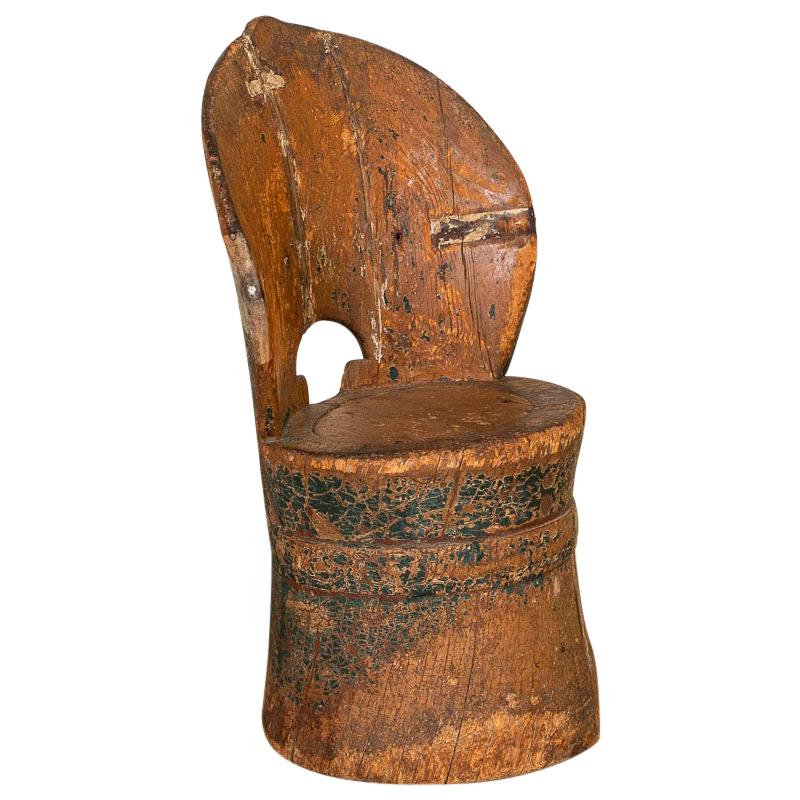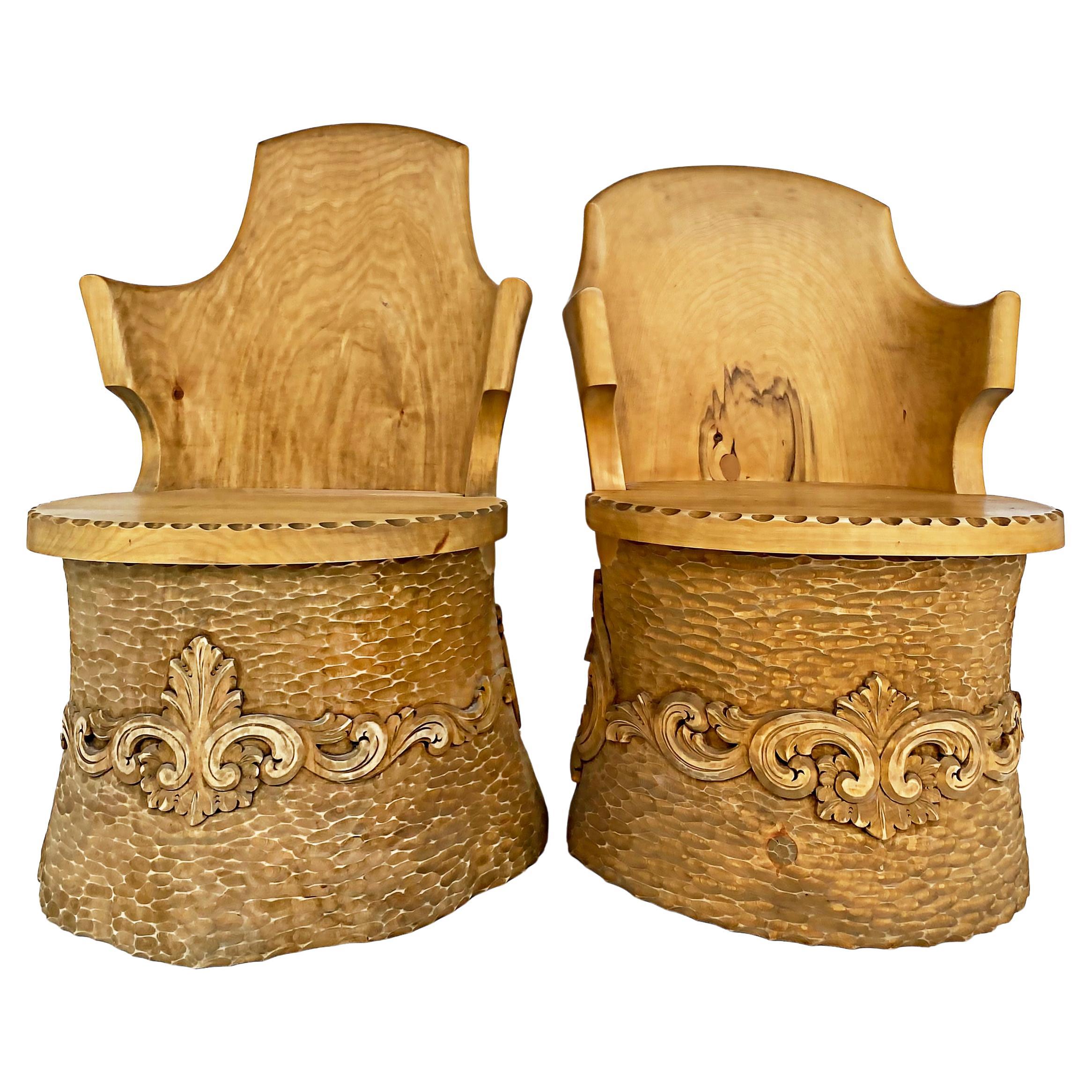Items Similar to Traditional Norwegian Carved Kubbestol, Norway early 20th century
Want more images or videos?
Request additional images or videos from the seller
1 of 16
Traditional Norwegian Carved Kubbestol, Norway early 20th century
About the Item
In Norway, cube chairs have been in use since the Middle Ages, and in the 18th and 19th centuries, cube chairs were mostly used in the farming communities in Eastern and Southern Norway.
Kubbestol or cube chair is traditionally carved out of a single block of wood. To reduce tensions in the material and prevent cracking, the block is usually hollowed out in the middle before the material is dried. This chair showcases this with unique hatches and under seat storage. Like many other Norwegian furniture types, the cube chair also has roots far beyond the country's borders. The look is most likely influenced by South European chairs of the same shape, carved in stone or made in bronze or clay. Such chairs are known from around 900 to 700 years before the birth of Christ. However, in Norway this type of chair has only been made of wooden blocks. In the case of this chair, the tree trunk was hollowed out while the back continues upward from the seat in a curved shield shape that makes the chair both snug and comfortable. Most likely this chair was made traditionally, roughly hewn while the material was raw. While the log is seemingly roughly shaped, the seating comfort is surprisingly high, as functionality has been historically important for Scandinavian furniture makers. The kubbestol was often placed next to the open-hearth fireplace or next to the bed, and it was reserved for the head of the household. The elemental organicity is evident through the cracks and decades old patina, creating a look that is just as coveted nowadays as Axel Einar Hjorth’s minimalistic pieces.
These days the kubbestol has become a symbol of Scandinavian roots for many families with ties to Norway, Sweden, or Denmark. A reminder of rural heritage and a time when most things in and around the home were made by hand from materials found in nature.
Condition:
In good vintage condition. Wear consistent with age and use. The chair has some cracks and marks.
Dimensions:
23.03 in W x 26.37 in D x 37.79 in H; Seat height 18.3
58.5 cm W x 67 cm D x 96 cm H; Seat height 46.5 cm
About the Design:
The earliest records of the kubbestol/kubbstol in Scandinavia are in the form of small silver amulets: one from a burial site on the island of Björkö to the west of Stockholm, which dates to the 9th century, and two found amongst a collection of money and jewellery unearthed at Fölhagen on the Swedish island of Gotland and dated to the 10th century.
Whereby it is important to remember that a representation of a kubbstol created in 9th and/or 10th century Sweden shouldn’t be confused with the physical existence of the kubbstol in 9th and/or 10th century Sweden. That while it strongly implies, they almost certainly were physically in existence in Sweden; they alone confirm that kubbstolar were known in Sweden, and presumably had an importance and significance. Why else use them as amulets, and as amulets crafted from precious, valuable, materials? In 1916 Bernhard Salin noted that “due to lack of time and space, I have to refrain from considering the interesting question of why the kubbstol during the Viking Age was made in the form of a pendant.”
Exactly what that significance is and was, other than, potentially, a simple symbol of the power of Odin and/or Frigg, we know not. As with all items of vernacular furniture the search for origins invariably leads one to supposition and fantasy, rather than your actual facts. However, the kubbstol became a symbol of Scandinavian history and culture, with a unique appearance and craftsmanship that contains history just like a book. ~H.
- Dimensions:Height: 37.8 in (96 cm)Width: 23.04 in (58.5 cm)Depth: 26.38 in (67 cm)Seat Height: 18.31 in (46.5 cm)
- Style:Scandinavian Modern (Of the Period)
- Materials and Techniques:
- Place of Origin:
- Period:
- Date of Manufacture:early 20th century
- Condition:Wear consistent with age and use. The chair has some cracks and marks.
- Seller Location:Utrecht, NL
- Reference Number:
About the Seller
5.0
Recognized Seller
These prestigious sellers are industry leaders and represent the highest echelon for item quality and design.
Platinum Seller
These expertly vetted sellers are 1stDibs' most experienced sellers and are rated highest by our customers.
1stDibs seller since 2017
358 sales on 1stDibs
Typical response time: 2 hours
Associations
20th Century Specialists
- ShippingRetrieving quote...Ships From: Utrecht, Netherlands
- Return PolicyA return for this item may be initiated within 7 days of delivery.
More From This SellerView All
- Traditional Carved Norwegian Kubbestol, Norway 1800sLocated in Utrecht, NLThis “kubbstol” or “kubbestol” is a traditional Scandinavian chair made from a log. The kubbestol was quite common in some districts of Norway from about 1750 to 1960, where it was usually made from logs with significant girth and three to four feet in length. The tree trunk was hollowed out so that the base (from the seat down) would be cylindrical while the back of the chair continues upward from the seat in a curved shield that makes the chair both snug and comfortable. Most, but not all, kubbestols were decorated with carving, painting, or some combination of the two. This chair has beautiful folk patterns hand carved into it, with visible, raw craftsmanship. Carved and painted decorations would differ from district to district and styles changed over time. While the log is seemingly roughly shaped, this chair is surprisingly comfortable, as functionality has been historically important for Scandinavian furniture makers. The kubbestol was often placed next to the open-hearth fireplace or next to the bed, and it was reserved for the head of the household. Large, impressive farmhouses might have had several richly carved and painted kubbestols as a display of wealth and status. These days the log chair has become a symbol of Scandinavian roots for many families with ties to Norway, Sweden, or Denmark. The kubbestol is a reminder of our rural heritage and a time when most things in and around the home were made by hand from materials found in nature. Essentially a chair hewn from a tree trunk, this chair is as closely associated with Norway as Peer Gynt...Category
Antique 19th Century Norwegian Brutalist Chairs
MaterialsWood
- Hand Carved African Baule Tribal Chairs, Ivory Coast, Early 20th centuryLocated in Utrecht, NLThe Baule Tribe from the Ivory Coast of West Africa is well-known for their artistic tribal art, sculptures, and furniture. With a rich cultural history, their creations are also full of history both visually and in their execution. This beautiful pair of chairs is the visual epitome of the tribe’s talents. The thin, wooden yokes...Category
Early 20th Century Ivorian Modern Chairs
MaterialsWood
- Rustic Solid Pine Chairs with Carved Backs, Europe early 20th centuryLocated in Utrecht, NLThis one-of-a-kind pair stands as evidence to the enduring charm of handcrafted furniture. These chairs tell a story of craftsmanship, history, and the timeless appeal of rustic beau...Category
Early 20th Century European Modern Chairs
MaterialsWood
- Carver Ladderback Chairs with Leather Seats, Europe Early 20th CenturyLocated in Utrecht, NLThis beautiful early midcentury pair of carver chairs combines historic elements with an organic design. Using natural materials and traditional techniques, the resulting aesthetic i...Category
Early 20th Century European Mid-Century Modern Side Chairs
MaterialsLeather, Wood
- Sculptural Patinated Oak Spinning Chair, Europe Ca Early 20th CenturyLocated in Utrecht, NLThe ‘spinning chair’, this historic type of seating has had numerous modern interpretations across Europe, however, most preserved the main functional characteristics: solid wood, enduring, high quality craftsmanship, a tall, straight back for good posture and freedom of movement. The art of spinning yarn is thousands of years old, but the spinning wheel as we know it is estimated to have arrived in Europe around the middle of the 13th century and along with it came the three or four-legged spinning chair. The backs were often hand carved with various motifs or fantasy creatures making each one unique and individual. As this oak chair shows, the Modernist movement influenced the traditional design by removing most of the intricate decorative elements, and substituting them with a more streamlined structure. The carved high back and octagonal seat...Category
Early 20th Century European Mid-Century Modern Chairs
MaterialsWood
- Late 20th Century Anglo-Chinese Chairs with Caned Seats, Europe 1980sLocated in Utrecht, NLThe influence of Chinese design on the West has been subtle, almost by osmosis, but we can see references in much of western art and design. Much of Europe has long had a magpie tradition of taking from the different cultures it has come into contact with in its past, furniture being no exception. Similar to European Chinoiseries, Britain formulated an Anglo-Chinese style that copied Chinese models yet adhered to British fashions affecting furniture design. The resulting aesthetic is quite unique and has evolved much in the past decades as demonstrated by these armchairs. These solid, exotic wood chairs...Category
Vintage 1980s European Other Chairs
MaterialsWood, Cane
You May Also Like
- Scandinavian Hand-Carved Kubbestol Chair, Norway or DenmarkLocated in Miami, FLScandinavian Hand-Carved Kubbestol Chair, Norway or Denmark Offered for sale is an extremely well-designed and ornately carved late 20h century Kubb...Category
Late 20th Century Norwegian Chairs
MaterialsWood
- Rare Norwegian Kubbestol, circa 1850, Origin Telemark, NorwayLocated in New York, NYRare Norweigen Kubbestol, circa 1850, origin: Telemark, Norway Rosemaling and acanthus carvings in this extraordinary Kubbestol indicate it is most likely from Telemark, Norway, a region known for this exact carving and painting. A Kubbestol is a traditional Scandinavian chair carved from a single log...Category
Antique 19th Century Norwegian Folk Art Chairs
MaterialsFir, Paint
- Antique Norwegian Small Kubbestol, Child's ChairLocated in Round Top, TXA kubbestol is a traditional Scandinavian chair made from a log. This one is unusual, as it is rare to find one scaled small for a child. Every knot, crack, and sign of wear adds to ...Category
Antique Early 19th Century Norwegian Chairs
MaterialsWood
- Early 20th Century Traditional Wood and Rattan Church ChairLocated in Barcelona, BarcelonaEarly 20th century traditional wood and rattan church chair By Unknown Manufacturer. France In original condition with minor wear consisitent of age and use, preserving a beautiful...Category
Vintage 1940s French Mid-Century Modern Chairs
MaterialsWood
- Norwegian Carved Kubbestol Chairs Hand-Carved Tree Trunks with Birds and TurkeyLocated in Miami, FLNorwegian Carved Kubbestol Chairs Hand-Carved Tree Trunks, Birds and Turkey Offered for sale is a pair of Norwegian Kubbestol hand-carved chairs...Category
Late 20th Century Norwegian Chairs
MaterialsWood
- Pair of early 20th century carved birch hall chairsLocated in Debenham, SuffolkPair of carved Swedish birch occasional chairs circa 1920, Heavily carved back rest with scrolls and acanthus leaves. Standing on turned front legs. Very minor marks to upholstery ...Category
Early 20th Century Swedish Victorian Chairs
MaterialsBirch
Recently Viewed
View AllMore Ways To Browse
Record Cubes
Viking Shield
Swedish Trunk Chair
Antique Single Wooden Bed
Swedish Kubbstol
Cube Chairs
Used Cube Chairs
Norwegian Antique Chairs
Axel Hjorth Book
Christ Head Pendant
Swedish Log Chair
Chairs Made From Logs
Used Household Furniture
Vintage Stone Chair
Nature Carved Chairs
Minimalistic Bed
Antique Viking Shield
Viking Jewelry Antique





